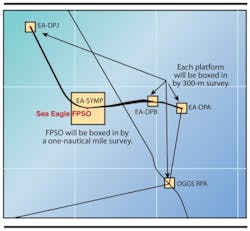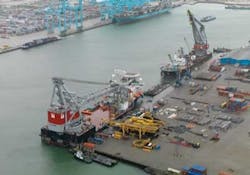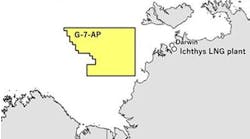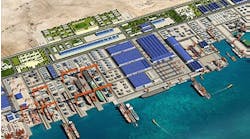Selecting fluid system components for use in sour oilfields
Gerhard Schiroky
Swagelok Co.
Many fluid system components are used in the oil and gas industry, including tubing, tube fittings, ball valves, double-block-and-bleed valves, manifolds, pressure gauges, and so on. These components are made from different materials of construction in order to meet requirements of industry standards and to provide safe, reliable service. The conditions under which oil and gas are brought from a reservoir to the surface can be outright hostile to many common materials. In marine environments, multiple threats exist that could lead to the degradation and even failure of a component. Potentially dangerous mechanisms include localized corrosion, stress corrosion cracking (SCC), and sulfide stress cracking (SSC). SSC is increasingly dominant as more sour reservoirs are being developed. For example, those in the northern part of the Caspian Sea contain up to 20% of hydrogen sulfide (H2S). Aging reservoirs can also turn sour as abiotic and biotic reactions take place, the latter involving microbes in the reaction of sulfur compounds to H2S. Selecting the optimal materials of construction, taking into consideration the impact of manufacturing processes, means your fluid system components will perform reliably for many years in the demanding sour environments of oil and gas exploration and production.
Localized corrosion
Pitting corrosion or crevice corrosion occurs when the chromium-rich passive oxide film on an alloy surface breaks down in a chloride-rich environment. Higher chloride concentrations, more acidic environments, and elevated temperatures all increase the likelihood for breakdown of this passive film. The higher an alloy’s Pitting Resistance Equivalent Number (PREN), the higher its resistance to localized corrosion. The most frequently used relationship for calculating PREN is:
PREN = %Cr + 3.3(%Mo + 0.5%W) + 16%N
Stress corrosion cracking
In the presence of chloride ions, e.g., in a marine environment, certain alloys are susceptible to SCC, or chloride-ion induced SCC. The chloride ion interacts chemically with the material at the very tip of a crack where tensile stresses are highest, making it easier for the crack to propagate. This failure mode is dangerous because it can destroy a component at stress levels below the yield strength of an alloy. While in progress, this failure mode can be difficult to detect, and final failure can occur suddenly.
In order for SCC to occur, three conditions must be met simultaneously: the material must be susceptible to SCC; the fluid must be capable of inducing SCC; and a tensile stress must be present that is greater than a critical tensile stress. The prevailing tensile stress is the sum of the applied tensile stress and any residual tensile stresses that may be present as a result of cold forming, welding, heat treatment, machining, or grinding.
Some alloys are considerably more prone to SCC than others. Nickel content of the alloy plays a major role in alloy resistance to SCC. Austenitic stainless steels like 304 with 8-10% nickel and 316 with 10-14% nickel are particularly susceptible. Three groups of materials are highly resistant to SCC: carbon steels, nickel-based alloys, and duplex stainless steels.
Sulfide stress cracking
Raw oil can be contaminated with undesirable compounds. When H2S and large quantities of carbon dioxide (CO2) are present, the unrefined fuels are said to contain “acid gas” because these gases form acids when mixed with water. The term “sour gas” is used for unrefined fuels containing H2S, a very corrosive, toxic, and flammable gas. Hence, fluid system components for transport of sour gas must be highly reliable and must be made from corrosion-resistant materials.
The requirements for SSC to occur are not unlike those for SCC. In a very similar manner, SSC requires a susceptible material; a sufficiently sour fluid, in other words a concentration of H2S above a specific threshold; and a tensile stress above a critical level.
Notwithstanding the similarities in the requirements for SSC and SCC to occur, a specific alloy may be highly susceptible to SSC and very resistant to SCC, or vice versa.
When failures of oil production and drilling equipment were first reported half a century ago during the development of sour reserves in western Canada and West Texas, many observations were made which were difficult to understand at that time. Failures occurred at stresses below a material’s yield stress, or even below the mechanical design stresses of equipment. Failure could occur in days, or could take months to materialize in the same type of component. Failure analysis often showed brittle fracture surfaces. And if the same grade of an alloy was used, failure was often associated with the stronger and harder alloys while parts made from the annealed softer alloys performed well.
Since the early days of observing component failures in sour gas, much has been learned about the nature of this failure mechanism. Factors that affect SSC have been identified and quantified. An increase in the following parameters can contribute to the rate at which SSC occurs: material properties such as tensile strength and hardness; hydrogen ion concentration in the fluid (i.e., pH-value); H2S partial pressure; total tensile stress (applied and residual); temperature; and exposure time.
On an atomic scale, SSC is a special case of hydrogen embrittlement. When a susceptible metal surface comes into contact with sour gas, the H2S molecules react to form metal sulfide and hydrogen atoms. The latter diffuse into the material at the tip of the crack at which tensile stresses are highest. Hydrogen diffusion and accumulation in the lattice, on interfaces and on grain boundaries, reduce the material’s ability to deform plastically, leading to hydrogen embrittlement that facilitates crack propagation.
Tube fittings and instrumentation valves for sour gas service available in alloys 825, 625, and 2507.
In sour environments such as mixtures of oil + seawater + H2S, SCC and SSC can pose a synergistic threat. Crack propagation caused by the chloride ion interaction with the tensile-loaded crack tip may proceed more readily if the material ahead of the crack tip has been embrittled by atomic hydrogen. The term environmental cracking is used to describe the synergistic actions of SCC and SSC.
Selecting materials for resistance to SCC and SSC
In 2003, an international standard was published that is available from the International Organization for Standardization as ISO 15156 and from NACE International as NACE MR0175/ISO 15156. The two forms are identical, have the same title “Petroleum and natural gas industries – Materials for use in H2S containing environments in oil and gas production,” and consist of three parts:
- Part 1 – General principles for the selection of cracking resistant materials
- Part 2 – Cracking-resistant carbon and low alloy steels, and the use of cast irons
- Part 3 – Cracking-resistant CRAs (corrosion-resistant alloys) and other alloys.
This standard gives requirements and recommendations for the selection and qualification of metallic materials for service in equipment used in oil and gas production and in natural gas sweetening plants in H2S-containing environments. It addresses all mechanisms of cracking that can be caused by H2S, including SSC and SCC, and other forms of hydrogen-induced cracking.
Pre-qualified materials are listed in the standard and can be used for the intended service without having to perform any additional laboratory testing. All listed materials with documented microstructural characteristics (e.g., annealed or strain-hardened) and properties (e.g., hardness) have performed satisfactorily in field installations or in laboratory tests carried out under defined environmental conditions.
In this standard, alloys are identified by material groups, and within each group, by materials type or as individual alloys. Acceptable metallurgical conditions and environmental limits are given for which alloys are expected to resist cracking. These conditions and limits are stricter for components for general use than for those in downhole installations. Environmental limits are given for H2S partial pressure, temperature, chloride concentration, in situ pH, and elemental sulfur. Key points are summarized below for the material groups of austenitic stainless steels, highly alloyed austenitic stainless steels, solid solution nickel-based alloys, and duplex stainless steels.
Austenitic stainless steels
Austenitic stainless steels comprise one material group that includes common alloys 304, 316, 317, 321, and 347. In addition, alloys 309, 310, Nitronic 50, and cast alloys such as CF8 and CF8M are part of this material group. Free-machining austenitic stainless steels which have elevated levels of sulfur are excluded specifically.
There are two sets of environmental limits. For a maximum use temperature of 60 ºC (140 ºF), the maximum H2S partial pressure is 100 kPa (15 psi). When the maximum chloride concentration is limited to 50 mg/L, the material can be used without restrictions on temperature and H2S partial pressure.
The NACE MR0175/ISO 15156 standard provides more detailed guidelines for austenitic stainless steels used to produce valve stems, seal rings, gaskets, and as components in compressors or in subsurface applications. Strain-hardened 316 stainless steel may be used in surface applications for compression fittings, instrument tubing, and control line tubing without restriction on temperature, H2S partial pressure, chloride concentration, or in situ pH in production environments. The standard cautions that while no limits on individual parameters have been set, some combinations of the values of these parameters may not be acceptable.
Highly alloyed austenitic stainless steels
Highly alloyed austenitic stainless steels comprise another materials group. If used for any equipment and components, type 3a and 3b alloys (e.g., 254SMO and AL6XN) are permitted in their solution-annealed state. For downhole tubular components, the alloys must have been solution annealed and may be in the cold-worked condition with a maximum hardness of 35 HRC. Type 3a and 3b alloys may be used in surface applications for compression fittings, instrument tubing, and control line tubing without restriction on temperature, H2S partial pressure, chloride concentration, or in situ pH in production environments.
Solid solution nickel-based alloys
The third materials group consists of solid-solution nickel-based alloys. The NACE MR0175/ISO 15156 standard defines five material types: 4a through 4e based on the Cr, Ni, Mo, and W content of the alloy, and its metallurgical condition, i.e., solution annealed or cold-worked. Commonly used alloys 825, 625, and C-276 to fulfill the requirements for types 4a through 4e can be used in the solution-annealed or annealed condition for any equipment or component at any combination of temperature, H2S partial pressure, chloride concentration, and in situ pH occurring in production environments. For downhole tubular components, cold-worked alloys 825, 625, and C-276 can be used so long as their hardness does not exceed 40 HRC and their yield strength is not above specific limits. Alloy C-276 can be used at higher temperatures and H2S partial pressures than alloy 625, which in turn is qualified for higher operating conditions than alloy 825. The standard gives detailed combinations of limits, temperatures, and H2S partial pressures.
Duplex stainless steels
Duplex stainless steels are divided into material types with lower PREN, between 30 and 40, and higher PREN, above 40 to 45. If used for any equipment, the alloys must be in the solution-annealed and liquid-quenched state, and have a ferrite content between 35% and 65%. Maximum use temperature is 232 ºC (450 ºF) for both material types. Maximum H2S partial pressure is 10 kPa (1.5 psi) for alloys with PREN between 30 and 40, and 20 kPa (3 psi) for alloys with PREN above 40. If used as downhole tubular components, the materials can be strain-hardened with a maximum hardness of 36 HRC. The lower PREN alloys can be used only up to a maximum H2S partial pressure of 2 kPa (0.3 psi), and the ones with PREN above 40 up to 20 kPa (3 psi) and a maximum chloride concentration of 120,000 mg/L.
Manufacture of fluid system components
Producing fluid system components that comply with all aspects of the NACE MR0175/ISO 15156 standard requires the use of high-quality raw materials, careful testing, and prudent choice of manufacturing methods. Alloys must have gone through a controlled solution annealing process, and their microstructural quality must be assessed with tests such as ASTM A262, which probes austenitic stainless steels for intergranular corrosion, or ASTM A923, which qualifies duplex stainless steels for absence of detrimental intermetallic phases. Austenitic stainless steels should be free of martensite and contain ideally no or at most 2% ferrite, because these phases are more susceptible to hydrogen embrittlement than austenite.
A sufficient number of hardness measurements must be performed and an average hardness value calculated, which must not exceed the respective allowed maximum value. No individual hardness reading is allowed that is greater than 2 units on the Rockwell C hardness scale above the allowed maximum hardness. When components are welded, care must be taken to perform hardness measurements on the welds following the procedures described in the NACE MR0175/ISO 15156 standard. Where solution-annealed materials are required, any cold drawing of bar or cold rolling of plate must be avoided. Cold deformation of surfaces is acceptable only if it is caused by processes such as burnishing that do not impart more cold work than typical machining operations. Identification stamping with low-stress stamps is acceptable, but the use of sharp V-stamping should not be performed in high-stress areas.
Material selection and manufacturing of fluid system components for service in sour gas environments are complex. The end user must define the prevailing sour gas service conditions, including those of steady state processes and of potentially unintended exposures. Other than material properties, there are several factors that affect the susceptibility of a material to cracking in sour fluids: H2S partial pressure, in situ pH, chloride concentration, presence of elemental sulfur, temperature, galvanic effects, mechanical stress, and time in contact with an aqueous solution. The end user should be familiar with the requirements of the NACE MR0175/ISO 15156 standard in order to select the optimal material of construction for a fluid system component.
When a customer orders a specific valve, fitting, or other fluid system component for sour gas service, the manufacturer should perform a product review in which all wetted parts are evaluated against standard requirements, e.g., for type of material, manufacturing processes, and maximum hardness. Such a review ensures that the products selected for sour gas service meet the requirements of the NACE MR0175/ISO 15156 standard, as well as the customer’s requirement for durability, performance, and reliable service.
Reference
1. NACE MR0175/ISO 15156, “Petroleum and natural gas industries—Materials for use in H2S-containing environments in oil and gas production” (Houston, TX: NACE International, 2003).
About the author
Gerhard Schiroky, senior scientist of Engineering, joined Swagelok in 2000. Schiroky is responsible for addressing customers’ materials issues and identifying opportunities for providing value-added solutions. He develops roadmaps for improved and new alloys, from which future fluid system components could be constructed. He also identifies and evaluates novel materials that offer performance or cost advantages.
Schiroky received his Ph.D. in Materials Science and Engineering from the University of Utah. He has authored numerous technical publications on diverse topics, including fluid dynamics and materials science, and is named on over 20 patents.







